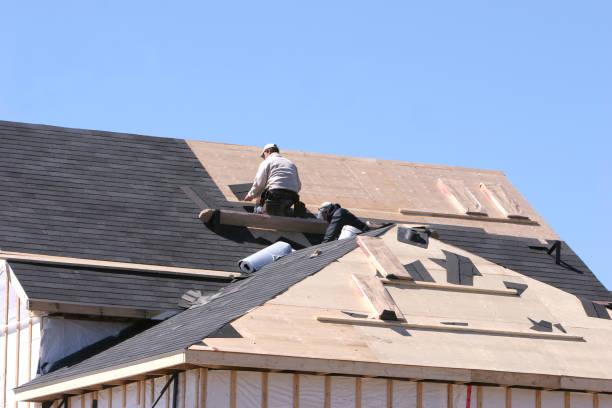All About Roofing Installation: A Comprehensive Guide

When it comes to maintaining or upgrading your home, few projects are as essential as roofing installation. Whether you're building a new house or replacing an old roof, understanding the roofing installation process can help you make informed decisions that save time and money. The type of material, the condition of your roof deck, and the installation method all play key roles in the performance and longevity of your roof.
For homeowners curious about how to spot roofing problems early, you can also explore this detailed roof repair guide to strengthen your understanding before taking on a full installation. In this post, we’ll break down the entire roofing installation process—from preparation to finishing touches—so you know exactly what to expect.
Why Roofing Installation Matters
A professionally installed roof is crucial for structural safety, energy efficiency, and long-term home value. Poor roofing installation can lead to water leaks, insulation problems, and even mold growth. Choosing the right materials and following a proven process can help extend your roof's lifespan, protect your belongings, and reduce long-term repair costs. Roofing installation also affects your home’s resale value and curb appeal—two factors often overlooked by homeowners during renovations.
Moreover, a properly installed roof contributes to better indoor temperature regulation, which can lower your heating and cooling bills throughout the year. It also ensures better resistance to harsh weather conditions such as heavy rain, snow, or high winds. Investing in high-quality roofing installation now can save you from emergency repairs and potential interior damage in the future. Whether you're replacing an old roof or building new, expert installation is the foundation of a secure, efficient, and long-lasting home.
Preparing for Roofing Installation
Before any materials go on your roof, proper preparation is essential. This includes:
-
Roof Inspection: Evaluate the current condition of the roof to determine if a full replacement is needed.
-
Permits and Regulations: Always check local building codes and obtain necessary permits.
-
Choosing Materials: Asphalt shingles, metal roofing, clay tiles, and synthetic options each offer different benefits.
-
Budgeting: Plan for labor, materials, disposal fees, and any potential structural repairs.
Step-by-Step Roofing Installation Process
Step 1: Remove Old Roofing
The existing shingles or material must be stripped down to the roof deck. This step ensures that hidden damage can be addressed before new materials are installed.
Step 2: Inspect the Roof Deck
Look for signs of rot, soft spots, or water damage. Damaged areas should be repaired or replaced to provide a solid base.
Step 3: Install Underlayment
This water-resistant or waterproof barrier is installed directly onto the deck to protect against leaks.
Step 4: Flashing Installation
Metal flashing is placed around chimneys, vents, and valleys to prevent water intrusion.
Step 5: Install Roofing Material
Shingles, metal panels, or tiles are applied according to manufacturer specifications, usually starting from the bottom edge of the roof.
Step 6: Ridge Caps and Vents
The top of the roof is sealed with ridge caps and vent systems to allow airflow and prevent moisture buildup in the attic.
Step 7: Cleanup and Final Inspection
Debris is removed, and the entire roof is checked for issues. A post-installation inspection ensures the job meets safety and quality standards.
Common Roofing Materials
Choosing the right roofing material is one of the most important decisions in any roofing installation. Each material offers unique benefits in terms of durability, appearance, cost, and suitability for different climates. Here’s a breakdown of the most common roofing materials used in residential installations:
1. Asphalt Shingles
-
Pros: Affordable, easy to install, widely available, and comes in various colors.
-
Cons: Shorter lifespan (15–30 years), may deteriorate faster in extreme weather.
-
Best For: Budget-conscious homeowners and traditional-style homes.
2. Metal Roofing
-
Pros: Extremely durable, fire-resistant, low maintenance, and energy-efficient.
-
Cons: Higher upfront cost, may be noisier during rain or hail.
-
Best For: Areas with harsh weather or homeowners seeking long-term value.
3. Clay and Concrete Tiles
-
Pros: Long-lasting (up to 100 years), excellent insulation, fire-resistant.
-
Cons: Heavy—requires reinforced roof framing; more expensive.
-
Best For: Mediterranean, Spanish, or Southwestern-style homes.
4. Slate Roofing
-
Pros: Elegant appearance, extremely durable (up to 100 years), fireproof.
-
Cons: Very heavy and expensive; complex installation.
-
Best For: Historic or high-end homes seeking classic charm.
5. Wood Shingles and Shakes
-
Pros: Natural look, eco-friendly, moderate insulation properties.
-
Cons: Prone to fire and moisture damage, requires regular maintenance.
-
Best For: Rustic-style homes in dry climates.
6. Synthetic Roofing (Rubber, Plastic, Polymer)
-
Pros: Lightweight, durable, often mimics natural materials like slate or wood.
-
Cons: Varies in quality; newer to the market so longevity is still being tested.
-
Best For: Homeowners looking for affordable alternatives to natural materials.
Tips for a Smooth Roofing Installation
-
Hire certified contractors with experience in your chosen material.
-
Schedule installation during dry, mild weather.
-
Review warranties on both materials and labor.
-
Prepare your home by moving outdoor furniture and protecting valuables inside from dust and noise.
-
Communicate regularly with your roofing team to stay informed.
Roofing Installation Costs
The cost of roofing installation can vary widely based on material, roof size, and location. Here’s a general range:
-
Asphalt Shingles: $3.50 – $5.50 per sq. ft.
-
Metal Roofing: $7.00 – $14.00 per sq. ft.
-
Clay or Concrete Tiles: $10.00 – $18.00 per sq. ft.
Labor costs, removal of old roofing, and permits can add significantly to these figures.
Conclusion
Roofing installation is a significant home improvement project that requires careful planning, quality materials, and skilled execution. From selecting the right roofing system to understanding each step of the installation process, homeowners who take the time to educate themselves are better equipped to protect their investment. Whether you're upgrading for durability, aesthetics, or resale value, following a comprehensive roofing installation guide ensures a result that lasts.
FAQs
Q1: How long does a roof installation take?
A: Most standard residential roofs take 1–3 days, depending on size and weather.
Q2: Can I stay in my home during the roofing installation?
A: Yes, but be prepared for noise and vibrations. It's safe, though possibly inconvenient.
Q3: What signs show I need a new roof?
A: Look for missing shingles, leaks, sagging, mold, or an aged roof past its expected lifespan.
Q4: Should I install a new roof or repair the old one?
A: It depends on the extent of the damage. Small issues can be repaired, but widespread damage often calls for a full replacement.
Q5: Do I need ventilation with a new roof?
A: Yes. Proper ventilation helps regulate attic temperature and prevents moisture buildup.





